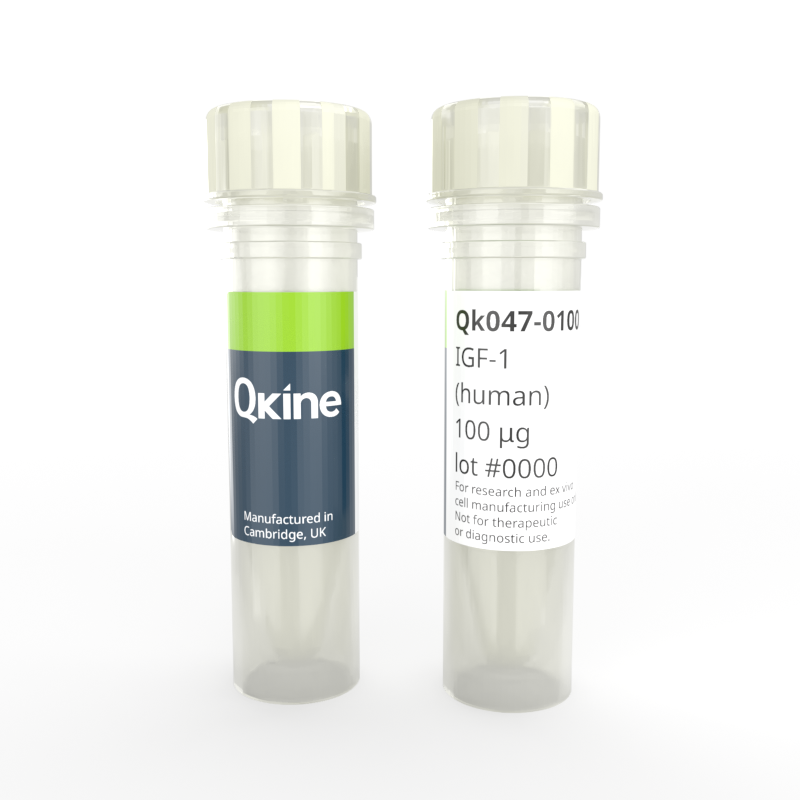Recombinant human IGF-1 protein
QK047
Brand: Qkine
Human insulin-like growth factor 1 (IGF-1) protein is used in the maintenance of human pluripotent stem cells (IPSC) and is necessary for cell growth in the absence of insulin. IGF-1 promotes the proliferation of many cell types, including embryonic stem cells (ESC) and mesenchymal stem cells (MSC).
Qkine IGF-1 is a highly pure and bioactive 8 kDa protein, Qkine growth factors are animal origin-free (AOF) and carrier-protein free (CF) for consistent stem cell culture.

Currency:
| Product name | Catalog number | Pack size | Price | Price (USD) | Price (GBP) | Price (EUR) |
|---|---|---|---|---|---|---|
| Recombinant human IGF-1 protein, 100 µg | QK047-0100 | 100 µg | (select above) | $ 95.00 | £ 70.00 | € 82.00 |
| Recombinant human IGF-1 protein, 500 µg | QK047-0500 | 500 µg | (select above) | $ 210.00 | £ 155.00 | € 182.00 |
| Recombinant human IGF-1 protein, 1000 µg | QK047-1000 | 1000 µg | (select above) | $ 285.00 | £ 210.00 | € 246.00 |
Note: prices shown do not include shipping and handling charges.
Qkine company name and logo are the property of Qkine Ltd. UK.
Alternative protein names
Species reactivity
human
species similarity:
mouse – 94%
rat – 96%
porcine – 100%
bovine – 100%
Summary
- High purity human IGF-1 protein (Uniprot:P05019)
- 8 kDa
- >98%, by SDS-PAGE quantitative densitometry
- Expressed in E. coli
- Animal origin-free (AOF) and carrier protein-free
- Manufactured in Qkine's Cambridge, UK laboratories
- Lyophilized from acetonitrile, TFA
- Resuspend in sterile-filtered water at >50 µg/ml, add carrier protein if desired, prepare single use aliquots and store frozen at -20 °C (short-term) or -80 °C (long-term).
Featured applications
- Maintenance of pluripotency in human iPSC
- Cell culture media optimisation and replacement of insulin in defined media
Bioactivity
IGF-1 activity was determined using the Promega serum response element luciferase reporter assay (*) in transfected MCF-7 cells. EC50 = 3.5 ng/ml (0.45 nM). Cells are treated in triplicate with a serial dilution of IGF-1 for 4 hours. Firefly luciferase activity is measured and normalized to the control Renilla luciferase activity. Data from Qk047 lot #104331. *Promega pGL4.33[luc2P/SRE/Hygro] #E1340

Purity
IGF-1 protein migrates as a single band at 10 kDa in non-reducing (NR) conditions and upon reduction (R). No contaminating protein bands are visible. Purified recombinant protein (3 µg) was resolved using 18% w/v SDS-PAGE in reduced (+β-mercaptothanol, R) and non-reduced (NR) conditions and stained with Coomassie Brilliant Blue R250. Data from Qk047 batch #104331.

Further quality assays
- Mass spectrometry: single species with expected mass
- Analytical reversed-phase: single sharp peak
- Endotoxin: <0.005 EU/μg protein (below level of detection)
- Recovery from stock vial >95%

Qkine IGF-1 remained bioactive in media for 7 days. Bioactivity was determined using an IGF-1-responsive firefly luciferase reporter assay. Transfected HEK293T cells were treated in triplicate for 4 hours with a serial dilution of IGF-1 which had been pre-incubated in conditioned media for 7 days. Firefly luciferase activity was measured and normalised to the control Renilla luciferase activity.
Protein background
The insulin-like growth factors (IGFs) are a family of proteins with a similar structure to insulin. IGF-1 has an A and B chain connected by disulphide bonds, its similarity to insulin means it can bind with low affinity to the insulin receptor [1]. IGF-1 is a primary mediator of growth hormone (GH), with growth-promoting effects on most cells and tissues including skeletal muscle, cartilage, bone, liver, kidney, nerve, skin, hematopoietic, and lung [1]. IGF-1 exerts its biological effect through binding to the IGF1 receptor (IGF1R), its effect is modulated through interaction with a group of binding proteins (IGFBPs), which tend to inhibit the effect of IGF-1 [2]. Through IGF1R the Ras-MAPK and PI3 kinase signaling pathways are activated leading to increased cell proliferation and survival [2].
IGF-1 can be used to support maintenance of human embryonic stem cell (ESC) [3] and mesenchymal stem cell (MSC) cultures [3, 4].
Background references
- Z. Laron. Insulin-like growth factor 1 (IGF-1): a growth hormone. Mol Pathol. 2001 Oct;54(5):311-6. doi: 10.1136/mp.54.5.311
- H. Werner. The IGF1 Signaling Pathway: From Basic Concepts to Therapeutic Opportunities. International Journal of Molecular Sciences. 2023; 24(19):14882. doi.org/10.3390/ijms241914882
- L. Wang, T.C. Schulz, E. S. Sherrer, D. S. Dauphin, S. Shin, A. M. Nelson, C. B. Ware, M. Zhan, C. Z. Song, X. Chen, S. N. Brimble, A. McLean, M. J. Galeano, E. W. Uhl, K. A. D’Amour, J. D. Chesnut, M. S. Rao, C. A. Blau and A. J. Robins. Self-renewal of human embryonic stem cells requires insulin-like growth factor-1 receptor and ERBB2 receptor signaling. Blood 2007 Dec 1;110(12):4111-9. doi: 10.1182/blood-2007-03-082586
- A. Youssef, D. Aboalola and V. K. Han. The Roles of Insulin-Like Growth Factors in Mesenchymal Stem Cell Niche. Stem Cells Int. (2017) 9453108. doi: 10.1155/2017/9453108
FAQ
What is the IGF-1 receptor pathway?
IGF1R is linked to various cytoplasmic second messenger molecules including the RAS-MAPK and PI3K signaling networks.
What is IGF-1?
IGF-1, also called somatomedin C, is a hormone with a similar molecular structure to insulin.
Where is IGF-1 found?
IGF-1 is primarily produced by the liver.
What does IGF-1 bind to?
IGF-1 binds to the IGF-1 receptor (IGF1R)
How is IGF-1 used in cell culture?
IGF-1 can be used in embryonic stem cell (ESC) and mesenchymal stem cell (MSC) cultures to promote proliferation, as a replacement to insulin.